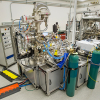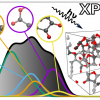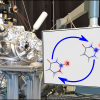
Researchers from Paderborn University, the Istituto Nazionale di Ricerca Metrologica (INRiM), Italy’s national metrology institute, the Politecnico di Torino, Italy, and the Physikalisch-Technische Bundesanstalt (PTB), National Metrology Institute of Germany, have studied sequential infiltration synthesis in nanostructured polymers. They hope to improve the possibilities for characterising material properties at the smallest length scale. Materials with structures in the range of just a few nanometres will be essential, for instance, in future computer chips, energy conversion and energy storage processes and molecular sieves.
At Paderborn, the team led by physicist Prof. Jörg Lindner works with nanostructured block copolymers, interlinked polymer chains that “self-organise” into regular patterns, allowing for a wide range of applications. “Our ability to control the self-organisation of block copolymers has made rapid progress in recent years”, says Lindner. In order to continue this development, though, non-destructive methods for characterising material properties must be expanded, as the goal of a larger endeavour involving the co-authors of partner institutions, INRiM, Politecnico di Torino and PTB.
Block copolymers allow extremely small structures to be created on semiconductor surfaces, which facilitates future-oriented processes for further miniaturising next-generation microelectronic components. “The structure sizes that can be achieved here are limited only by the length of the polymer chains, so they can be even smaller than the structures that are laboriously produced through conventional techniques. The advances in miniaturisation also create a need for new measurement methods and size standards so that smaller structures can be analysed. Block copolymers can help here, too—but only after the chemical differences between the involved polymer types are increased by selectively modifying one of the polymers. Selectively integrating aluminium oxide using sequential infiltration synthesis makes it possible to create nanostructures that can be used to test these new measurement processes”, explains Lindner. These measurement processes include reference-free grazing incidence X-ray fluorescence. More qualitative depth distribution results were validated by means of X-ray photoelectron spectroscopy and scanning transmission electron microscopy combined with energy-dispersive X-ray spectroscopy.






